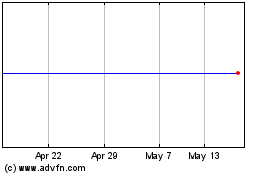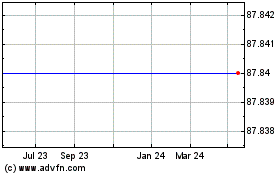Siemens AG - Final Results
November 06 1997 - 5:08AM
UK Regulatory
RNS No 0503f
SIEMENS AG
5th November 1997
Growth targets for fiscal 1997 exceeded - earnings up
Continued dynamic growth in international markets - domestic business stagnates
- sales top DM100 billion for first time - dividend of DM1.50 proposed -
outlook for fiscal 1998: net income above DM3 billion
Siemens AG, Berlin and Munich, exceeded its growth targets for fiscal 1997
(ended September 30). As in the previous year, buoyant international growth
more than offset stagnating domestic business. The communications segment and
Siemens Nixdorf Informationssysteme AG (SNI) were the major growth drivers for
the year. Semiconductors also picked up notably toward the end of the year,
after a weak start. Net income rose 5% to DM2.61 billion. The company will
propose a dividend of DM1.50 per 5-mark share at the Annual Shareholders'
Meeting.
Worldwide, new orders for the year climbed 12% to DM113.1 (1996: DM100.8)
billion. Sales rose 14% to DM107.0 (1996: DM94.2) billion, topping the
100-billion mark for the first time. Both international orders and sales showed
double-digit increases, up 23% and 22% respectively; orders hit DM77.5 (1996:
DM62.8) billion, and sales reached DM70.6 (1996: DM57.8) billion. Overall
growth was pushed up five percentage points by positive currency conversion
effects and the first-time consolidation of new companies. All of the company's
business segments showed double-digit international growth rates.
International activities now account for 69% (1996: 62%) of the total.
Siemens' regional companies as well as its exports from Germany profited from
the strong international business.
Business in the Asia-Pacific region again boomed; orders jumped 45% to DM16.4
(1996: DM11.2) billion as Siemens continued to expand its market position.
Profiting from the upswing in North and South America, Siemens saw orders there
increase 24% to DM22.8 (1996: DM18.4) billion. In the U.S. alone, business grew
16% to DM15.1 (1996: DM13.0) billion. The strongest growth in the Americas was
recorded in Brazil, where orders soared 75% to DM4.0 (1996: DM2.3) billion,
positioning the country second in line to the United States in business volume.
Business in Europe outside Germany also surged, climbing 14% to DM31.9 (1996:
DM28.0) billion. Siemens enjoyed above-average growth in its core countries of
Western Europe - Britain, Italy and France.
In Germany, however, business continued to stagnate. Sales matched last year's
level at DM36.4 (1996: DM36.4) billion, while orders slipped to DM35.6
(1996: DM38.0) billion. Business remained sluggish as a result of fewer major
infrastructure projects, domestic industrial activities that picked up only
toward the end of the year, and the virtually completed digitization of Deutsche
Telekom's network.
At September 30, 1997, Siemens had approximately 386,000 employees worldwide,
some 7,000 or 2% more than at the close of the previous year. Using comparable
figures, the German workforce declined by 3,000. An additional 3,000 jobs were
no longer consolidated at Siemens, but were retained outside the company.
Overall, the number of employees in Germany dropped to 197,000. Private
Communication Systems and Semiconductors continued to increase their domestic
workforces during the year. The number of employees outside Germany grew by some
13,000 to around 189,000, largely due to the consolidation of new companies.
Capital spending for the year totaled DM9.8 (1996: DM7.9) billion; the
increase also reflects the acquisition of AEG Electrocom. Higher capital
expenditures were primarily attributable to outlays made to expand semiconductor
production capacity.
Net income rose 5% to DM2.61 (1996: DM2.491) billion. Earnings were burdened
by higher restructuring charges. Lower profits in the energy, health care,
components, and transportation segments were largely compensated by increased
earnings in the other groups. Financial results were up over the previous year.
Lower profits in the energy segment reflected the difficult market environment
in which Power Generation (KWU) and Power Transmission and Distribution (EV)
operate. Pressure on prices continued unabated. Privatization and deregulation
trends in EV's markets throughout the world fueled restructuring, fiercer
competition, and massive price declines outside Germany. Restrained investments
by utilities companies continued to cut domestic demand. At KWU, the
introduction of new technologies delayed some projects, impacting earnings.
The industry segment, comprised of Industrial and Building Systems (ANL), Drives
and Standard Products (ASI), and Automation (AUT), showed solid improvement for
the year. Following a rigorous restructuring program and a loss in fiscal 1996,
ANL is back in the black. ASI posted a strong jump in earnings, and AUT
improved its already high level of profits. The segment made the second largest
contribution to the company's income. Nevertheless, Siemens' industrial business
continued to be impacted by weak demand in the capital goods market and by
Germany's recessive construction market. The segment's weak domestic order level
was offset by favorable developments in international markets. Both AUT and ASI
noted a light revival of domestic business in the last quarter of the year.
By far the largest contribution to earnings was made by the communications
segment. Public Communication Networks (OEN) more than doubled its earnings.
Private Communication Systems (PN) nearly matched its last years high results.
Both groups saw their international business continue to boom. OEN, for example,
did nearly 80% of its business outside Germany, profiting from demand for its
EWSD digital switching system in South America and for its mobile phone systems,
above all in Asia. PN showed solid growth in mobile telephones and applications.
Siemens Nixdorf Informationssysteme AG (SNI) also posted high growth rates,
especially in its international business with PCs, solutions and services. SNI's
net income of DM105 million for the year shows an improvement over fiscal
1996.
Medical Engineering's (MED) double-digit growth in orders and sales in its
international markets more than offsets stagnating orders and lower sales in
Germany. Earnings at MED, however, were adversely affected by ongoing
cost-cutting measures in the health-care industry, particularly in Germany and
the U.S., and by sharply eroding prices. Restructuring measures designed to meet
these challenges burdened the group's earnings with a high extraordinary charge,
leading to an overall loss.
Trends in the transportation segment were mixed. While Automotive Systems (AT)
sustained its positive thrust of previous years and pushed up earnings by 30%,
Transportation Systems (VT) slipped into the red for the year, due to high
up-front investments for major projects in Asia, and a second restructuring
phase necessitated by the group's rapid growth in recent years.
Following a weak start early in the year, the components segment gained
substantial momentum and showed double-digit growth in both orders and sales. As
anticipated, earnings for the segment were lower than last year's high level.
Semiconductors (HL) resumed its growth after the market situation stabilized.
The group's earnings were impacted by an extreme deterioration of prices.
In the lighting segment, Osram GmbH more than compensated for weakened demand
in Germany with solid double-digit growth in its international markets,
particularly Latin America. Osram's earnings also showed above-average growth.
The company will propose a dividend of DM1.50 per 5-mark share at the Annual
Shareholders' Meeting on February 19, 1998. The capital stock has increased to
DM2.86 billion from DM2.80 billion last year. Based on this capital stock, the
dividend payment will total DM857 (1996: DM840) million.
The company expects to sustain above-average growth rates in its international
business for the current fiscal year. In Germany, improved economic conditions,
particularly in the industrial sector, should boost domestic business. Siemens
expects earnings growth to be significantly higher than the increase in business
volume; at present the company sees net income exceeding the DM3 billion level
for the first time.
DEVELOPMENT OF SIEMENS GROUPS WORLDWIDE (INCL. INTERSEGMENT SHIPMENTS)
(PRELIMINARY FIGURES FOR 1996/97; IN DM BILLION; NOT YET AUDITED)
Income before taxes (in DM million)
1995/96 % v.U. 1996/97 % v.U.
Power Generation (KWU) 410 5,1 255 2,7
Power Transmission and Distribution (EV) 42 0,7 -149 -2,3
Industrial and Building Systems (ANL) -102 -1,1 7 0,1
Drives and Standard Products (ASI) 117 1,3 285 3,1
Automation (AUT) 509 7,8 581 7,2
Public Communication Networks (ON) 354 3,0 797 5,5
Private Communication Systems (PN) 503 5,8 460 4,2
Defence Electronics (SI) 63 4,0 105 7,1
Siemens Nixdorf Information Systems (SNI) 52 0,4 105 0,7
Transportation Systems (VT) 19 0,4 -177 -4,3
Automotive Systems (AT) 111 2,8 153 3,4
Medical Systems (MED) 30 0,4 -170 -2,2
Semiconductors (HL) 603 12,9 109 1,8
Passive Components and Electron Tubes (PR) 239 11,7 216 9,5
Electromechanical Components (EC) 34 2,6 15 1,2
Osram 369 6,5 468 7,4
PRELIMINARY FIGURES FOR 1996/97; NOT YET AUDITED
1.10.95 1.10.96
to to
30.9.96 30.9.97 Change 30.9.96 30.9.97 Change
------------------------------------- ---------------------------------------
New
orders (Mrd. DM) 100,8 113,1 12% Employees (Tsd.) 379 386 2%
Domestic 38,0 35,6 -6% Domestic 203 197 -3%
business operations
International 62,8 77,5 23% International 176 189 7%
business operations
------------------------------------- ---------------------------------------
1.10.95 1.10.96 1.10.95 1.10.96
to to to to
30.9.96 30.9.97 Change 30.9.96 30.9.97 Change
------------------------------------- ---------------------------------------
Sales (Mrd. DM) 94,2 107,0 14% Capital 7,9 9,8 25%
spending (Mrd. DM)
Domestic 36,4 36,4 0% Net 2,491 2,61 5%
business income (Mrd. DM)
International 57,8 70,6 22%
business
END
FR FSMFEIUWUFIF
Siemens N Ord (LSE:SIE)
Historical Stock Chart
From Jun 2024 to Jul 2024

Siemens N Ord (LSE:SIE)
Historical Stock Chart
From Jul 2023 to Jul 2024
